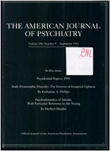Cognitive features of borderline personality disorder
Abstract
Of 50 patients with borderline personality disorder, 100% reported disturbed but nonpsychotic thought, 40% (N = 20) reported quasi- psychotic thought, and none reported true psychotic thought during the past 2 years; only 14% (N = 7) reported ever experiencing true psychotic thought. Disturbed and quasi-psychotic thought was significantly more common among these patients than among patients with other axis II disorders or schizophrenia and normal control subjects; however, true psychotic thought was significantly more common among schizophrenic patients. While disturbed thought was also common among axis II disorder and schizophrenic patients, quasi-psychotic thought was reported by only one of these subjects, suggesting that quasi- psychotic thought may be a marker for borderline personality disorder.
Access content
To read the fulltext, please use one of the options below to sign in or purchase access.- Personal login
- Institutional Login
- Sign in via OpenAthens
- Register for access
-
Please login/register if you wish to pair your device and check access availability.
Not a subscriber?
PsychiatryOnline subscription options offer access to the DSM-5 library, books, journals, CME, and patient resources. This all-in-one virtual library provides psychiatrists and mental health professionals with key resources for diagnosis, treatment, research, and professional development.
Need more help? PsychiatryOnline Customer Service may be reached by emailing [email protected] or by calling 800-368-5777 (in the U.S.) or 703-907-7322 (outside the U.S.).



